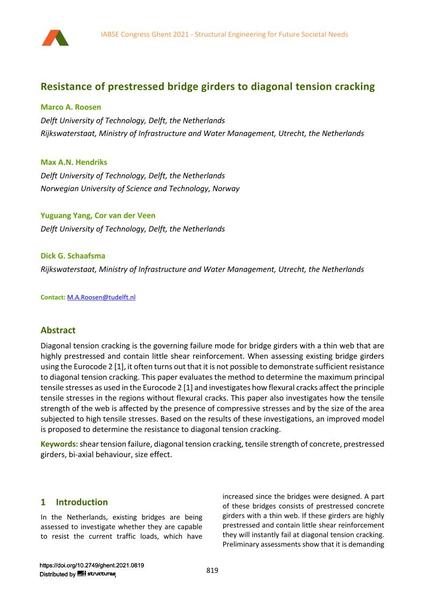Resistance of prestressed bridge girders to diagonal tension cracking

|
|
|||||||||||
Détails bibliographiques
| Auteur(s): |
Marco A. Roosen
(Delft University of Technology, Delft, the Netherlands; Rijkswaterstaat, Ministry of Infrastructure and Water Management, Utrecht, the Netherlands)
Max A. N. Hendriks Yuguang Yang Cor van der Veen (Delft University of Technology, Delft, the Netherlands) Dick Schaafsma (Rijkswaterstaat, Ministry of Infrastructure and Water Management, Utrecht, the Netherlands) |
||||
|---|---|---|---|---|---|
| Médium: | papier de conférence | ||||
| Langue(s): | anglais | ||||
| Conférence: | IABSE Congress: Structural Engineering for Future Societal Needs, Ghent, Belgium, 22-24 September 2021 | ||||
| Publié dans: | IABSE Congress Ghent 2021 | ||||
|
|||||
| Page(s): | 819-827 | ||||
| Nombre total de pages (du PDF): | 9 | ||||
| DOI: | 10.2749/ghent.2021.0819 | ||||
| Abstrait: |
Diagonal tension cracking is the governing failure mode for bridge girders with a thin web that are highly prestressed and contain little shear reinforcement. When assessing existing bridge girders using the Eurocode 2 [1], it often turns out that it is not possible to demonstrate sufficient resistance to diagonal tension cracking. This paper evaluates the method to determine the maximum principal tensile stresses as used in the Eurocode 2 [1] and investigates how flexural cracks affect the principle tensile stresses in the regions without flexural cracks. This paper also investigates how the tensile strength of the web is affected by the presence of compressive stresses and by the size of the area subjected to high tensile stresses. Based on the results of these investigations, an improved model is proposed to determine the resistance to diagonal tension cracking. |
||||
| Copyright: | © 2021 International Association for Bridge and Structural Engineering (IABSE) | ||||
| License: | Cette oeuvre ne peut être utilisée sans la permission de l'auteur ou détenteur des droits. |
||||
